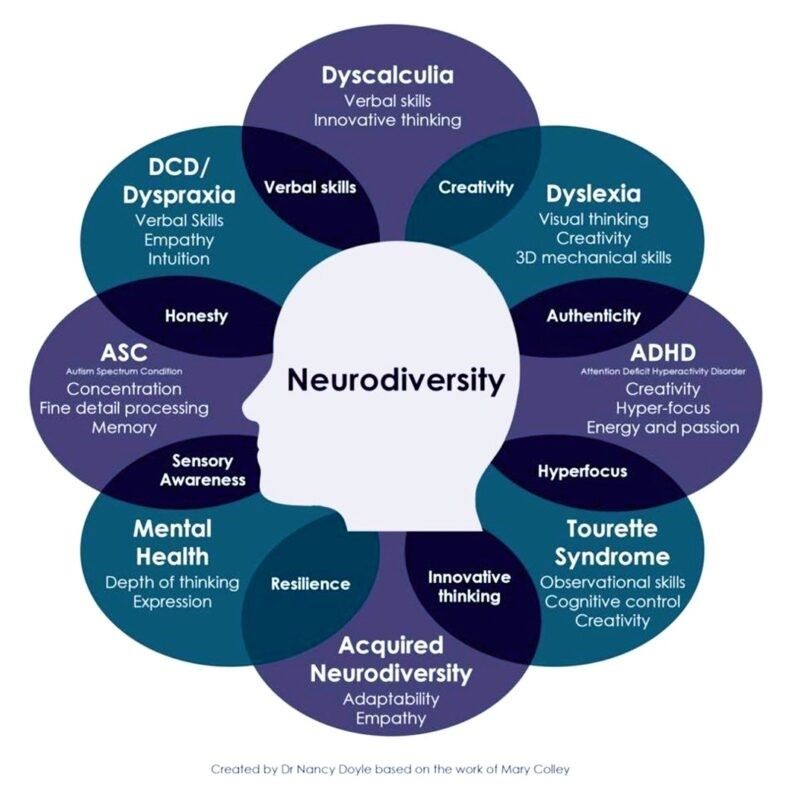
Neurodiversity: an introduction
An introduction to Neurodiversity
18th to 24th March is Neurodiversity Celebration Week. During the week, we will be providing information about various aspects of neurodiversity, what BNU is doing to foster a neuroinclusive environment in which we can study and work, and sharing some colleagues’ lived experiences.
What do we mean by ‘neurodiversity’?
According to the Chartered Institute for Personnel and Development (CIPD)1.
‘While all brains are different, some people with broadly similar ways of thinking, communicating and processing information can have a sense of shared identity and experience. For example, an identity as autistic, dyslexic, dyspraxic or as an ADHDer. People who possess one or more such neuroidentities often identify and are referred to as ‘neurodivergent’. Someone who does not may be referred to as ‘neurotypical’, though in reality neurotypicality is highly contextual, and there is no one ‘normal’ brain.’
There are many groupings included under the umbrella term ‘neurodivergent’, but although they can be useful to help us understand and support, no two brains are alike. What works for one person with dyslexia or ADHD, for example, may not help another.
Are neurodivergent conditions considered a disability?
Under the Equality Act (2010), a disability is classified as ‘a physical or mental impairment that has a substantial and long-term negative effect on your ability to do normal daily activities’. Substantial is more than minor or trivial – e.g. it takes much longer than it usually would to complete a daily task and long-term means 12 months or more
Some neurodivergent people may feel that they fall under this definition and others may not; it is for the individual to decide.
Should someone declare a disability if they fall under this definition?
Some people choose not to disclose a condition, even if they consider themselves to fall under the definition of a disability. Common concerns are that it could be perceived by others as a stigma or weakness, it may change the way people think about them, it doesn’t apply to them if they haven’t had an official diagnosis, or that they do not want or need any extra support.
Others choose to disclose, either to their lecturer or tutor, manager, a member of the Disability and Inclusion team, or a colleague from HR or from their own team. Disclosing a condition can enable the appropriate support to be put into place, including signposting to support and advice and introducing reasonable adjustments to help them study or work. Some can be funded through the Access to Work scheme (ask your HRBP for further details), and some may be simple adjustments to ways of working or studying to accommodate their needs.
It is important to remember that we try to help and support everyone with their individual needs at BNU, regardless of whether this relates to a disability.
I think I might be neurodivergent. Should I get a diagnosis?
There are often significant waiting times for assessments, through the NHS and other routes. You do not need a diagnosis to make a disclosure or to apply for help. We recognise that there is no ‘one size fits all’ approach, that there can be barriers to people getting the support they need, and that there are sometimes additional difficulties that people experience when they have multiple conditions or other complicating circumstances. We have introduced inclusion passports for both staff and students to that they can make others aware of any particular needs they have and how we can support these needs and help our students and colleagues thrive at BNU. You can find the details on BEN.
What are the positive aspects of being neurodivergent?
Traditionally, the focus has been on the deficits experienced by neurodivergent individuals compared to ‘neurotypical’ individuals. However, increasingly, we are recognising that alongside aspects of thinking and learning that neurodivergent individuals may find challenging, there are also areas of strength to be harnessed and celebrated.

This diagram was created by Dr Nancy Doyle and shows some of the most common groupings of neurodivergence and where there are overlapping strengths of those conditions.
Where can I find more information?
Please contact the HR team or the Disability and Inclusion team for individual and confidential help or advice. Our Employee Assistance Provider, also offers help and advice to individuals and managers.
You can also find online training modules on neurodiversity and mental health on our e-learning platform.
Further information about Neurodiversity Celebration week can be found on this website, and Lexxic is running free webinars throughout the week.
1.CIPD
Further resources:
- Podcast – supporting students with neurodiversity
- Lexxic’s Neurodiversity Smart Employer Guide
- Manager’s Toolkit: Inclusive management practices at BNU
- LinkedIn article on managing ND employees